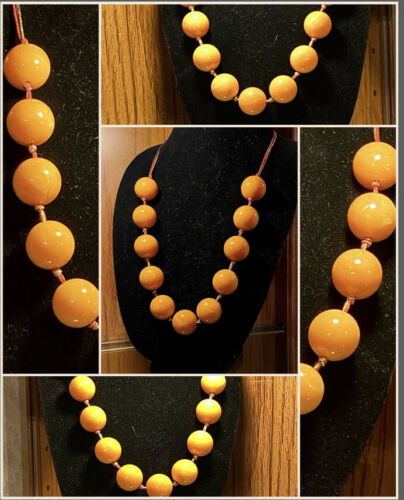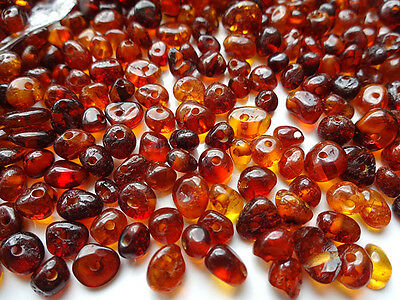-40%
Baltic Butterscotch Egg Yolk Amber Estate Necklace Antique Vintage Beads ON SALE
$ 105.59
- Description
- Size Guide
Description
Baltic Butterscotch Egg Yolk Amber$ 500.00 PRICE DROP!
DONT LET THIS NECKLACE PASS YOU BY!!
Round Beaded Necklace
An amazing example of a set of amber beads.
The beads are threaded on knotted material one purple one pink and one gold.
The back of the necklace has two smaller accenting beads.
I am unsure of the origin of the piece because it was part of a family estate.
Pictured are the authentication
testing's
and of other random validations that one might want to know or see. Y
ou
are able to
see the beads with the quarter that is aside them for a better idea of the sizes
,469 Please DO NOT hesitate to make ANY reasonable offer!
Also if you want to make it a buy it now let us know and we can change that over and get it out in the post to you !
Making
up
this beautiful estate necklace are
the following as well as the specific details:
13 beads roughly weighing 104gm - coming to roughly 20.8ctw.
11 Large beads roughly weighing 94gm total measuring roughly 7/8 in or 22mm round.
2 Smaller beads (in the back) roughly weighing 10 gm total measuring 3/4 in or 19mm round.
The Following information is only based on my own personal research of the necklace and the testing of it. It has not been taken to a jeweler or been looked at by any sort of gemologist. I personally looked up testing to authenticate these beads at home and the following tests were done with results to follow.
Pictures of the testing results taken to provide more validity to the results.
This key is based on a wide selection of
jewelry
in the collection of the National Museums Scotland
1) The
Salt Water
Test (Easiest & Most Effective):
This test is extremely easy and effective. All you
have to
do is mix two cups of warm water salt water. Once you have done this, place the piece of amber in the solution. If the piece of amber floats to the
top
then it is indeed authentic amber.
Result – Floating as seen in pictures and it truly looks like a sunny side up egg when you look at the pictures
2) The Rubbing Test (Simple & No Mess):
One of the easiest methods, when you rub real amber on the palm of your hand, it is said to give off its iconic smell. This occurs due to the heating effect produced by friction between your hand and the amber piece. If you employ this method and there is no pine-tree scent, then your amber piece is most likely not authentic.
3) The Feel Test (Straightforward & Super Easy):
Genuine amber is lightweight and slightly warm to the touch. This is due to it being underground for millions of years and because of its chemical composition. You can distinguish fake amber that is made of glass from the real thing because glass is harder, cooler, and heavier than authentic amber.
Result – This when squeezed between your fingers as odd as it sounds feels
soft
but it is a solid bead if that makes sense. It almost if I had to describe it in
generic
terms feels like an old school hard rubber ball. Like a solid core and a rubber coating.
4) The Hardness Test (Quick & Uncomplicated):
Another important and easy way to check your amber piece is by checking its hardness. By conducting this test, you can immediately determine whether the amber piece is real or not. Genuine amber is relatively soft. Most fakes are either hard solids or have that plastic feel to them. With small beads, all you
have to
do is press them between your thumb and index finger.
Results
– This test was done with a
alteration
of the test and that is to take a fine needle and lightly scratch the bead in a place unseen. If it digs into the bead its likely amber if it scratches
it
is likely glass. Our testing shows that it went into the bead and was not a
surface scratch
.
5) The alcohol test: put a drip of alcohol on the surface, let it evaporate and see if it goes sticky. This is good test for copal (hardened tree resin) which is generally too soft for
jewelry
. Recently forgers have found a way of hardening copal to make it look and feel like amber, but we have not yet been able to get a necklace of this for testing, so this is not yet included in the key below.
Result – The beads all wiped clean no sticky residue and no
left over
hazing.
6) The
Simichrome
test- put a bit of
Simichrome
polish on a cotton bud, rub the surface of the bead and look at the
colour
of the residue. This test has been used for identifying Bakelite necklaces however it is not a good test. Red Bakelite produces a red/brown
residue,
however a similar result was observed from red polyester and a red plastic that we could not identify. Yellow Bakelite and yellow polyester produced a yellow residue. Clearly what you are seeing is the
colour
of the dye in the
beads
so this test is not included in the key below.
Results – The q tip was clean of any colors and all that resides is the polish on the top. This was done twice and as you can see pictured the same result again.
The
Walk through
key below is our last and final validation that we went through.
1) Can the beads be scratched with a pin?
Yes.
Amber or plastic. Go to 4.
No. They are also heavy and cold to the touch. Glass or semi-precious stones. Go
to 2.
2) Are the beads identical in
colour
and shape? (They can be different sizes).
Yes. Glass.
No. Go to 3.
3) Are the beads striped? Yes. Agate.
No.
Probably chalcedony. An orange/red form of chalcedony is called Carnelian.
4) Can you see separate chips of amber?
Yes.
Polybern
- amber chips embedded in polyester resin.
Usually
the resin is transparent and amber-
coloured
, but opaque white or black resin has also been used. Where the maker has been
lean
with the use of amber chips, the chips are only found on one side.
No. Go to 5.
5) Do the beads float in a saturated salt-water solution?
Yes. Amber or polystyrene. Go to 6.
No. Plastic. Go to 11.
6) Are the beads transparent/translucent or opaque?
Transparent/translucent. Go to 7.
Opaque. Go to 8.
7) Do some of the beads have bulbous
centres
to the string holes?
Yes. Polystyrene.
No. Amber. The beads may contain inclusions such as small insects, bark fragments and oak hairs (only visible with a hand lens). Oak hairs are a good indicator of Baltic amber. If the beads contain spangles (circular cracks) then they have been heat-treated. Old beads may be crazed (fine surface cracks).
8) Is every bead identical in shape?
(They can be different sizes).
Yes.
Amber or polystyrene. Go to 9.
No. Amber.
9) Do the beads contain dark swirls?
Yes. Polystyrene.
No
. Amber or polystyrene. Go to 10.
10) Are the beads different shades of
colour
?
Yes.
Amber.
So we stop there.
No.
P
ol
ystyrene or amber. It is rare to get every bead of opaque amber the same shape and
colour
. Old amber can be crazed (fine surface cracks), though polystyrene can be coated with acetate which cracks and can peel off in places.
11) Are the beads transparent/translucent or opaque? Transparent/translucent. Go to 12.
Opaque. Go to 14.
12) Do some of the beads have bulbous
centres
to the string holes and/or
mould
lines along the beads?
Yes. Acrylic.
No. Go to 13.
13) Do the beads contain spangles (circular cracks) or deep surface cracks?
Yes. Polyester.
No. Probably Bakelite,
though could be acrylic, celluloid or an unidentified plastic. Bakelite beads, mostly made in the 1920s and 1930s can be either smooth or faceted, and are usually oval, spherical or barrel-shaped. Red is the most common and popular
colour
, but other
colours
also exist. Other similar beads of other plastics also exist.
14) With a hand lens, can you see machine lines around the beads and fine crazing? Yes.
Galalith
. This is a rare early plastic made from casein (milk protein) and formalde
hyde). The necklaces we have seen are a dirty greenish/yellow
colour
.
No. Go to 15.
15) Does it contain swirls?
No. Probably Bakelite, or celluloi
d.
Yes. Go to 16.
16) Can you see
mould
lines around the beads?
Yes. Acrylic.
No. Bakelite, acrylic, polyester
I know that this is a lengthy description however we like to know that before we list something, even if its or ,000 dollars no matter what we take
minutes
or even hours to make sure that we are selling the actual item not just a guess or a whim.
So please take a moment to go through all of our authentication processes. It was a long process to get all of the information brought to you about this piece but when you are looking at a pricy item no matter who you are you want peace of mind when you hit bid don't we?
Thanks!
Condition is Beautifully "Pre-owned Estate” condition shipped free to you from our
non smoking
well cared for home so you can start to enjoy this stunning old piece asap!




















